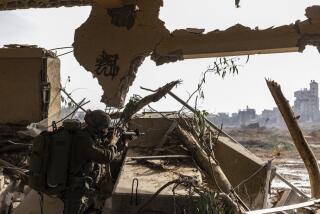What did, and didn’t, the Army know?
There is a profound difference between watchfulness and a witch hunt.
In the aftermath of the Ft. Hood shootings, that’s a crucial distinction, though nothing the authorities -- and particularly the U.S. Army brass -- have said so far has done much to help people make it. In fact, after Monday’s revelations concerning the botched federal investigation into Maj. Nidal Malik Hasan’s repeated contacts with a notorious jihadi imam, the military’s initial response to the killings in Texas takes on a new coloration. Army Chief of Staff Gen. George W. Casey Jr.’s insistence that “speculation [about Hasan’s Islamic faith] could potentially heighten backlash against some of our Muslim soldiers,” for example, now looks less like a sensible plea for tolerance and more like a familiar defensive maneuver designed to protect the rear ends of guys with stars on their shoulders.
As we now know -- and as Casey surely knew when he made that remark -- the 39-year-old American-born son of Palestinian immigrants had been giving off warning signs of personal distress and instability for much of his Army career. Other physicians in training programs in which he studied formally complained to their superiors about his expression of anti-American, pro-jihadi views in what were supposed to be presentations on psychiatric medicine. He reportedly was “counseled” during his residency at Walter Reed Army Medical Center for proselytizing.
According to U.S. officials, late in 2008 and into January of this year, federal anti-terrorism operations intercepted 10 to 20 e-mails between Hasan and Anwar al Awlaki, an American-born imam who now preaches jihadism from Yemen. Awlaki isn’t just any clerical extremist; he’s one of the movement’s rock stars, a joke-cracking English-speaker who operates an influential Al Qaeda-linked website. More than that, as a radical imam in mosques in San Diego and Virginia -- the latter attended by Hasan -- he met with at least two of the 9/11 hijackers. A subsequent FBI investigation forced him to flee to his parents’ native country, where’s he’s been in and out of jail. British authorities have banned him from addressing audiences in their country. On Monday, he praised Hasan as a “hero” on his website and urged other American Muslim soldiers to emulate his example.
Yet the FBI and, reportedly, military investigators concluded that Hasan, who’d hired a lawyer to help him get out of the Army, was pursuing harmless research into post-traumatic stress syndrome. Thus, no notice was taken when he subsequently bought two high-powered handguns at a Texas gun store -- purchases reported to the FBI. The two handguns he is said to have carried into the reception room on the day of the outrage were easily and legally purchased at a nearby store charmingly named “Guns Galore.” According to ABC News, the more lethal of the two -- an FN Herstal Five-seveN -- is often called “the cop killer” because of its firepower. The semiautomatic pistol’s standard clip holds 20 rounds, and a clip extension, which Hasan purchased, adds 10 more. So, assuming one cartridge in the chamber, he could have fired 31 times without reloading. Early forensic reports say more than 100 rounds were fired.
Clearly, the FBI screwed up here, but so did the Army. For years, Hasan displayed signs that he was a troubled man, and religion may simply have been the lens through which his inner disquiet focused itself. If convicted, he’d hardly be the first American killer of whom that’s true. The Army’s apparent willingness to ignore this may have had less to do with promoting “diversity” or “multiculturalism” than it did with the service’s large financial stake in Hasan’s medical training and the hard time the military has in recruiting competent mental health professionals. We need answers, not obfuscation, on all this, and the Army brass needs to cough them up -- quickly.
In the meantime, there is a need for perspective that doesn’t impugn the more than 3,000 Muslim soldiers now serving their country in the Army. The accusations against Hasan cut to the bone because, if true, he violated not only his oath as a commissioned officer but also his Hippocratic oath as a healer of war’s most intimate wounds. Still, it’s well to remember that military fratricide is an ancient and recurring problem.
More than a century ago, the most famous of Rudyard Kipling’s “Barrack-Room Ballads” -- “Danny Deever” -- drew on an actual incident to recount the story of a regiment forced to watch the hanging of one of its privates who had murdered another soldier. As the “colour-sergeant” narrator says:
For ‘e shot a comrade sleepin’ -- you must look ‘im in the face;
Nine ‘undred of ‘is county an’ the regiment’s disgrace.
Nor are issues of divided loyalty foreign to the history of the U.S. military. During the Mexican-American War, hundreds of Irish immigrants and a handful of Germans -- all Catholics -- deserted and joined the Mexicans when they discovered that most of their American comrades were nativists bent on a crusade against Catholicism. As the San Patricio Battalion, they provided the Mexican army with its best horse-drawn artillery. After the fall of Mexico City, those who fell into U.S. hands were either hanged or flogged and branded.
None of the implications of Hasan’s alleged betrayal are unique to Islam. When dealing with soldiers far from their homes and families and subject to the greatest imaginable stress, the Army needs to be on the watch for the predatory inroads of any form of political or religious extremism -- whether it be the jihadism to which Hasan was drawn or the Christian identity nonsense that inspired Timothy McVeigh.
--
More to Read
Start your day right
Sign up for Essential California for news, features and recommendations from the L.A. Times and beyond in your inbox six days a week.
You may occasionally receive promotional content from the Los Angeles Times.






